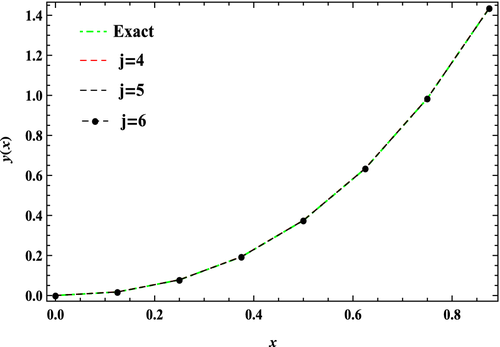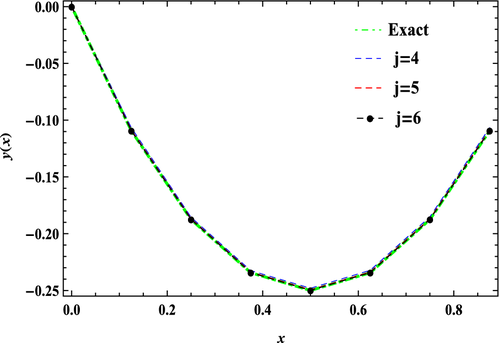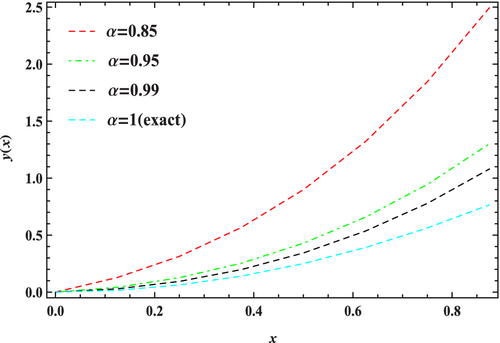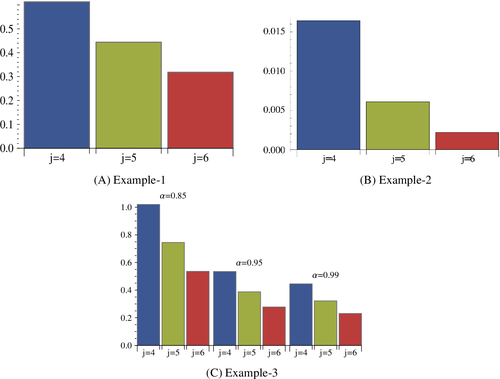Wavelet-based collocation technique for fractional integro-differential equation with weakly singular kernel
Funding information: University Grants Commission, 16-9(june2017)/2018(NET/CSIR)
Abstract
Fractional integro-differential equation (FIDE) with weakly singular kernel is an important topic in mathematics and engineering dealing with mathematical modeling and simulation of numerous systems and processes. A wavelet-based collocation technique has been developed here to obtain approximate numerical solution of a FIDE with weakly singular kernel. The present method avoids complicated integrations and elaborate numerical calculations. The multiscale error approximation associated with this method has also been explained. The efficiency of the proposed method has been demonstrated by including some illustrative examples.
1 Introduction
Application of fractional calculas was introduced by Abel in the solution of integral equation arising in the formulation of tautochrone problem. In recent times different types of integro-differential equations (IDE) and fractional integro-differential equations (FIDE) have been formulated with the purpose of obtaining accurate description of complex phenomena including modeling and simulation of different systems and processes. Among the fractional calculas, FIDE with weakly singular kernel is a relatively new branch in mathematics and has gained considerable popularity and importance due to their vast applications. Many standard mathematical models of integer order derivative including nonlinear models have some limitations to describe the phenomena properly. So, FIDE with different types of singularities have been formulated to describe the physical problems including fracture mechanics, fluid flow, heat conduction problem, dynamical system, and so on.1-3
Here represents the fractional derivative of order of the unknown function y(x) and the fractional derivative is understood in Caputo sense in this paper. The explicit forms of V(x, t) and f(x) are known and they are considered sufficiently smooth to confirm the existence and uniqueness of solution.4
Solving of FIDE with weakly singular kernel might be difficult analytically, so many researchers have tried to propose different accurate and efficient numerical methods. In very short time a lot of different numerical methods have been proposed such as spline collocation,5 second kind Chebyshev polynomial method,6 Legendre wavelets,7 an operational Jacobi Tau method,8 Hat function,9 Shifted Jacobi polynomials,10 Block pulse,11 Taylor wavelets,12 and so on. All these methods provide adequate results. Though all these methods have some advantages in some sense but some appeared to be somewhat elaborate. Also in some methods numerical calculations have become unmanageable so as to make the method unattractive. These limitations of mentioned methods together with numerous appearence of FIDE with weakly singular kernel in different fields motivate us to construct a staightforward numerical scheme to solve Equation (1) avoiding numerical complexity.
In this paper, a wavelet-based collocation technique has been proposed to solve FIDE with weakly singular kernel of the form given by (1). The method based on wavelet for solving integral and differential equations has various important features due to multiresolution properties of the space of functions spanned by the wavelets. Wavelet is a special kind of oscillating function and it has been used for decades in digital signal processing and image compression. Here the unknown function in Equation (1) is expanded in tems of wavelet basis of Daubechies family. Under the selection of suitable collocation points, the FIDE is reduced to a system of linear algebraic equations with unknown coefficients involved in the expansion of the unknown function y(x) of FIDE (1). The obtained results are effective in further investigation in the field of FIDE with Cauchy kernel, hypersingular kernel, and other types of special singular kernels.
2 Basic preliminaries and notations
2.1 The fractional derivative and integrals
There exists a vast literature on various types of definitions on fractional derivatives (FD) and fractional integrals (FI). The conventional definitions of fractional derivatives include Caputo FD, Riemann-Liouville FD, Caputo -Frabizio FD, Atangana-Baleana FD, Riesz FD, and so on. Also the conventional definitions of fractional integrals include Riemann-Liouville FI, Hadamard FI, Atangana-Baleana FI, and so on. The widely used definition of FD is the Caputo definition and FI is the Riemann–Liouville definition.
Definition 1.Caputo's fractional derivative of order is defined as12
Definition 2.The Riemann–Lioville fractional integral operator of order is defined as12
The relation between the Riemann–Lioville operator and Caputo operator is given below
2.2 Collocation method
2.3 Multiscale (wavelet) basis of Daubechies family
Trigonometric functions, exponential functions or orthogonal polynomials associated with some self-adjoint operators are used as basic building blocks to approximate a function or represent an operator in approximation theory. If the building block contains n elements, then the operators or functions are constituted by n × n matrix and n × 1 vectors respectively. In the action of functions or operators, O(n2) or O(n4) operations are needed. So if n increases, then a large number of operations is needed. A comprehensive mathematical theory known as multiresolution analysis (MRA) has received considerable attention to overcome the limitation mentioned above. Daubechies invented a compactly supported orthogonal wavelet basis that can be generated from a single function known as scale function with the aim to serve the MRA of .
3 Method of approximation
The superscript s in and will be I or R according as . Equation (22) represents a system of 2j number of algebraic equations with 2j number of unknown coefficients . After determining , the value of the unknown function y(x) can be determined at any dyadic point in [0, 1]. In order to calculate y(x) at any arbitrary point x other than dyadic point, the dyadic approximation of x has to be used.15
4 Evaluation of matrix elements
To determine the unknown coefficients involved in the expansion of the unknown function of FIDE in terms of basis of Daubechies family, we have to calculate numerical values of the elements of each of the matrices . Hence the prime task for wavelet-based collocation method for FIDE with weakly singular kernel is the numerical evaluation of the integrals and .
4.1 Evaluation of
The support of and is [0, 2K − 1] for Dau-K family of scale function. If k ≤ 0, then range of integration in (27) and the support [0, 2K − 1] have no nonempty intersection. Hence, if k ≤ 0, vanishes.
In the evaluation of , the values of n depend on as Table 1 displays the values of for (k = 0, 1, 2, … , 2K − 1) taking Daubechies family of wavelets with K = 3 for . In this calculation n = 1 is taken as . can be evaluated for any other values of using the formula (35).
| k | |||
|---|---|---|---|
| 1 | 1.77224 | 2.78268 | 5.94309 |
| 2 | −1.13093 | −2.56704 | −6.90373 |
| 3 | 0.12730 | 0.36169 | 1.32940 |
| 4 | −0.04753 | −0.05757 | 0.00573 |
| 5 | −0.04176 | −0.05839 | −0.06126 |
This recurrence relation follows from Equation (13) and normalization condition is constructed with the help of determination of unknown coefficients involved in the expansion of in terms of Daubechies scale functions at zero scale level over .
4.2 Evalution of
Here , are weights are nodes of Gauss Daubechies quadrature rule involving Daubechies scale function.16
In Table 2 the values of for k = 1, 2, … , 5 are given taking Dau-3 scale function for . For other values of these can be easily calculated.
| k | |||
|---|---|---|---|
| 1 | 0.925995 | 1.643812 | 4.018044 |
| 2 | 1.064183 | 0.954199 | 0.410716 |
| 3 | 0.808341 | 0.682604 | 0.691069 |
| 4 | 0.748236 | 0.560703 | 0.424904 |
| 5 | 0.699178 | 0.488824 | 0.341744 |
4.3 Evaluation of
If , then the range of integration [0, 2j − k] is equivalent to [0, 2K − 1], support of the scale function . Again if , then the range of integration is converted to . are the weights and nodes for the full support [0.2K − 1] as range of integration. are the weights and nodes for the the partial support as the range of integration. The values of are tabulated in the tables 6.7 and 6.8 in the article.16
5 Multiscale approximation and Error estimation


In Equations (58) and (59), if k takes the values b2j − r (r = 2K − 2, 2K − 3, … , 1) from then k1 takes the values b2j + 1 − r (r = 2K − 2, 2K − 3, … , 1) from . The main aim here is to calculate the values of , as are determined in the preceding section. The coefficients can be determined by the matrix equation (55) after expressing the matrix U using the relation (59). One needs the coefficients at level j + 1 to evaluate at level j.
In the above calculation, the terms and are neglected as they take values zero or nearly zero.
6 Illustrative examples
Here, three examples are given to test the efficiency of wavelet-based collocation technique developed here in the numerical solution of FIDE.
Example 1
In Table 3, the approximate solution obtained by present method at the resolution level j = 4, 5, 6 together with the exact solution y(x) of example 1 are shown at the points To find approximate results, we take Dau-3 scale function and we use 5-point Gauss-type quadrature rule involving Daubachies scale function. The approximate results together with exact values are displayed in Figure 1. Both the Table 3 and Figure 1 show excellent agreement between approximate and exact results.

| Approximate solution | ||||
|---|---|---|---|---|
| x | Analytical solution | j = 4 | j = 5 | j = 6 |
| 0 | 0 | 0 | 0 | 0 |
| 1/8 | 0.017578 | 0.018131 | 0.017660 | 0.017590 |
| 2/8 | 0.078125 | 0.078666 | 0.078209 | 0.078138 |
| 3/8 | 0.193359 | 0.193996 | 0.193461 | 0.193375 |
| 4/8 | 0.375000 | 0.375781 | 0.375124 | 0.375019 |
| 5/8 | 0.634766 | 0.635718 | 0.634916 | 0.634789 |
| 6/8 | 0.984375 | 0.985523 | 0.984555 | 0.984403 |
| 7/8 | 1.435550 | 1.436920 | 1.435760 | 1.435580 |
Example 2

| Approximate solution | ||||
|---|---|---|---|---|
| x | Analytical solution | j = 4 | j = 5 | j = 6 |
| 0 | 0 | 0 | 0 | 0 |
| 1/8 | −0.109375 | −0.106636 | −0.108771 | −0.109235 |
| 2/8 | −0.187500 | −0.185570 | −0.187039 | −0.187378 |
| 3/8 | −0.234775 | −0.232564 | −0.233905 | −0.234249 |
| 4/8 | −0.250000 | −0.248064 | −0.249493 | −0.249864 |
| 5/8 | −0.234375 | −0.232249 | −0.233816 | −0.234224 |
| 6/8 | −0.187500 | −0.185134 | −0.186877 | −0.187332 |
| 7/8 | −0.109375 | −0.106724 | −0.108676 | −0.109186 |
Example 3
The proposed method is used here to find approximate numerical solutions of Equation (67) at j = 4, 5, 6 for different values of . These obtained data are displayed in Table 5. It is observed that the approximate results approach to the exact solution y(x) = x2 as approaches to 1. A large amount of computational error may occurred, if we use the proposed method for . The reasons for this situation are mentioned in Section 4.1. Figure 3 shows approximate results for different values of for a particular resolution level (j = 6). The figure shows a good agreement between proposed method and the block pulse method.11

| Approximate solution | ||||
|---|---|---|---|---|
| x | j = 4 | j = 5 | j = 6 | |
| 0 | 0 | 0 | 0 | |
| 1/8 | 0.112945 | 0.120189 | 0.128218 | |
| 2/8 | 0.289574 | 0.301993 | 0.313809 | |
| 3/8 | 0.533670 | 0.550261 | 0.567142 | |
| 4/8 | 0.853351 | 0.875169 | 0.898505 | |
| 5/8 | 1.260050 | 1.288430 | 1.319820 | |
| 6/8 | 1.767760 | 1.804240 | 1.845560 | |
| 7/8 | 2.393540 | 2.439880 | 2.493400 | |
| 0 | 0 | 0 | 0 | |
| 1/8 | 0.043537 | 0.041757 | 0.042350 | |
| 2/8 | 0.128188 | 0.125409 | 0.126612 | |
| 3/8 | 0.257204 | 0.252693 | 0.253495 | |
| 4/8 | 0.434511 | 0.427714 | 0.428633 | |
| 5/8 | 0.665486 | 0.655790 | 0.656846 | |
| 6/8 | 0.956892 | 0.943553 | 0.944764 | |
| 7/8 | 1.317050 | 1.299150 | 1.300540 | |
| 0 | 0 | 0 | 0 | |
| 1/8 | 0.031570 | 0.028000 | 0.028700 | |
| 2/8 | 0.098675 | 0.094359 | 0.093878 | |
| 3/8 | 0.204922 | 0.198407 | 0.197593 | |
| 4/8 | 0.344445 | 0.875169 | 0.343201 | |
| 5/8 | 0.549646 | 0.536764 | 0.534976 | |
| 6/8 | 0.798021 | 0.780695 | 0.778222 | |
| 7/8 | 1.105620 | 1.082770 | 1.079440 | |
| Example 3 | |||||
|---|---|---|---|---|---|
| j | Example 1 | Example 2 | |||
| 4 | 1.67697(10−1) | 2.32942(10−4) | 4.47105(10−1) | 1.28896(10−1) | 9.01604(10−2) |
| 5 | 9.29065(10−2) | 3.21493(10−5) | 2.54939(10−1) | 7.07976(10−2) | 4.91910(10−2) |
| 6 | 4.91481(10−2) | 4.21763(10−6) | 1.37523(10−1) | 3.74053(10−2) | 2.58997(10−2) |
| 7 | 2.53064(10−2) | 5.40004(10−7) | 7.16031(10−2) | 1.92644(10−2) | 1.33155(10−2) |
| 8 | 1.28440(10−2) | 6.83182(10−8) | 3.65568(10−2) | 9.78067(10−3) | 6.75445(10−3) |
In Table 6, the values of given by Equation (64) are represented for the examples 1, 2, and 3, respectively, for different values of j. It is observed from Table 6 that the values of gradually decrease if the resolution level j is gradually increased. and ,0.128035 are taken to determine the upper bound of L2-norm error for examples 1 and 2, respectively. Three distinct values of are considered to find approximate numerical solutions for the example 3. For the evaluation of the upper bound of L2-norm error of the example 3, the three sets of namely ; , and are used for three distinct values of mentioned earlier at the resolution level j = 4, 5, 6. The upper bound of L2-norm error together with sup error (for example 1 and 2) are shown in Table 7. Sup errors are calculated taking the maximum absolute error of y(x) at the points . The upper bound of L2-norm error at the resolution level j = 4, 5, 6 for different values of for example 3 are shown in Table 8. The bar diagrams of upper bound of L2-norm error are shown in Figure 4 for the examples 1, 2, and 3 to show dependence of the accuracy of the proposed method on the resolution level j. The bar diagrams are self-explanatory.

| j | Sup error | Bound | |
|---|---|---|---|
| Example 1 | 4 | 1.36935 × 10−3 | 6.13300 × 10−1 |
| 5 | 2.14625 × 10−3 | 4.44135 × 10−1 | |
| 6 | 3.34970 × 10−5 | 3.18301 × 10−1 | |
| Example 2 | 4 | 2.73919 × 10−3 | 1.64389 × 10−2 |
| 5 | 6.99367 × 10−4 | 6.08307 × 10−3 | |
| 6 | 1.88892 × 10−4 | 2.19930 × 10−3 |
| j | |||
|---|---|---|---|
| 4 | 1.01993 × 100 | 5.34758 × 10−1 | 5.35634 × 10−1 |
| 5 | 7.45000 × 10−1 | 3.87432 × 10−1 | 2.77718 × 10−1 |
| 6 | 5.35634 × 10−1 | 2.77718 × 10−1 | 2.30878 × 10−1 |
7 Conclusion
This paper demonstrates a wavelet-based collocation technique to solve FIDE with weekly singular kernel arising in various mathematical models and simulations of systems and processes. The method illustrated here provides a simple way of obtaining approximate numerical solutions avoiding complicated integrals and complexity of calculations. The wavelet-based collocation technique can also be applied to solve non-linear FIDE with weakly singular kernel. However, the actual method depends on the form of the nonlinearity. The validity and applicability of the method is illustrated through three examples and it appears that the method gives favourable results. The bar diagrams analyse that the bounds of error have the reverse proportional relation with the resolution level j. The convergency rate of the proposed method is comparatively fast for lower fractional order for a fixed resolution level j. The efficiency in obtaining approximate numerical solutions depends on the choice of resolution level j. The results can be improved by taking larger resolution level j.
Acknowledgements
The authors thank the Reviewers for their comments and suggestions to revise the paper in the present form. Jyotirmoy Mouley acknowledges financial support from University Grants Commission, New Delhi, for the award of research fellowship (File no. 16-9[june2017/2018(NET/CSIR)]).
Biographies

Jyotirmoy Mouley is a research scholar (Senior Research Fellow, UGC, New Delhi, India) of the Department of Applied Mathematics, University of Calcutta, Kolkata, India. He works to find numerical solution of integral and differential equations arising in different field of mathematical physics using bases of different wavelets family. His interest areas of research include Integral equations, Differential equations, Numerical analysis, and Wavelet analysis.

B. N. Mandal is a retired professor in Physics and Applied Mathematics Unit of Indian Statistical Institute, Kolkata. His specialization is in applied mathematics having expertise on water waves, integral equations, integral transforms, differential transforms, numerical analysis, wavelets, inventory and queuing in OR etc. He has published more than 290 research papers in these topics and and also coauthored/edited 10 research monographs.




